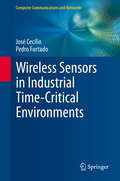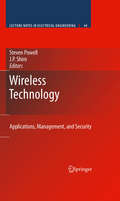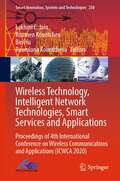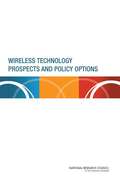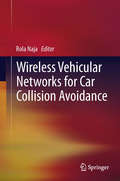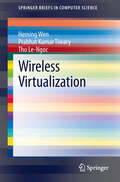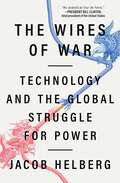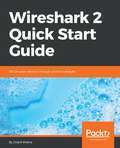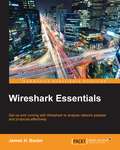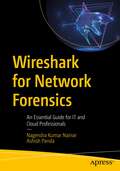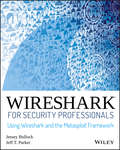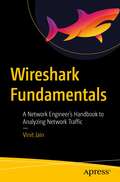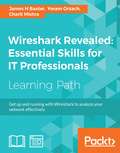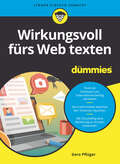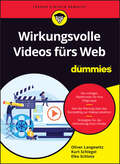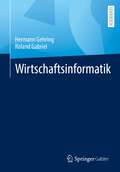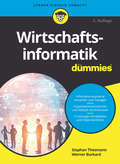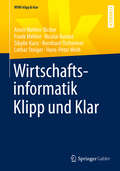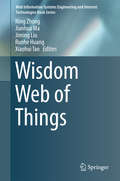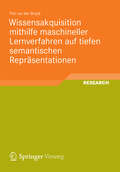- Table View
- List View
Wireless Sensors in Industrial Time-Critical Environments
by José Cecílio Pedro FurtadoThis book introduces the fundamentals of DCS, and shows how to include wireless technology in their design while guaranteeing the desired operation characteristics. The text also presents insights and results gained from extensive practical experience in implementing and testing systems within a specific industrial setting. Features: examines the operations that the DCS implements, covering human-machine interfaces, diagnostics and maintenance interfaces, and controllers; discusses industrial control system and wireless network protocols; reviews scheduling in wireless sensor networks; describes a latency model for heterogeneous DCS with wired and wireless parts, that predicts monitoring, command, and closed loop latencies; explains how to plan operation timings systematically; introduces measures and metrics for performance monitoring and debugging, and describes how to add these to a system; presents experimental results to validate the planning approach, based on an application test-bed.
Wireless Technology
by Steven Powell J. P. ShimThis is an edited volume based on selected papers from the annual Wireless Telecommunications Symposium. The WTS is a forum to exchange information on advances in mobile communications and wireless networking technology, management, applications, and security in a conference environment with leaders and experts from industry, governmental agencies, and universities around the world. The key topics from the symposium include: 1) Wireless Network Security, 2) Advances in Satellite Communications, 3) New Wireless Communications Ventures, 4) Wireless Communications Investments, 5) Mobile Wireless Services and Business, 6) Future Directions in Wireless Communications Research. The best papers from the conference were selected, expanded, and edited to produce this cohesive volume.
Wireless Technology, Intelligent Network Technologies, Smart Services and Applications: Proceedings of 4th International Conference on Wireless Communications and Applications (ICWCA 2020) (Smart Innovation, Systems and Technologies #258)
by Lakhmi C. Jain Roumen Kountchev Bin Hu Roumiana KountchevaThis book gathers selected papers presented at the 4th International Conference on Wireless Communications and Applications (ICWCA 2020), held at Hainan University, China. The second volume will involve research works aimed at the contemporary applications: emerging wireless/mobile applications, context and location-aware wireless services; wireless telemedicine and e-health services; intelligent transportation systems; RFID technology and application; cognitive radio and sensor-based applications; content distribution in wireless home environment and many others.
Wireless Technology Prospects and Policy Options
by National Research Council of the National AcademiesThe use of radio-frequency communication--commonly referred to as wireless communication--is becoming more pervasive as well as more economically and socially important. Technological progress over many decades has enabled the deployment of several successive generations of cellular telephone technology, which is now used by many billions of people worldwide; the near-universal addition of wireless local area networking to personal computers; and a proliferation of actual and proposed uses of wireless communications. The flood of new technologies, applications, and markets has also opened up opportunities for examining and adjusting the policy framework that currently governs the management and use of the spectrum and the institutions involved in it, and models for allocating spectrum and charging for it have come under increasing scrutiny. Yet even as many agree that further change to the policy framework is needed, there is debate about precisely how the overall framework should be changed, what trajectory its evolution should follow, and how dramatic or rapid the change should be. Many groups have opinions, positions, demands, and desires related to these questions--reflecting multiple commercial, social, and political agendas and a mix of technical, economic, and social perspectives. The development of technologies and associated policy and regulatory regimes are often closely coupled, an interplay apparent as early as the 1910s, when spectrum policy emerged in response to the growth of radio communications. As outlined in this report, current and ongoing technological advances suggest the need for a careful reassessment of the assumptions that inform spectrum policy in the United States today. This book seeks to shine a spotlight on 21st-century technology trends and to outline the implications of emerging technologies for spectrum management in ways that the committee hopes will be useful to those setting future spectrum policy.
Wireless Vehicular Networks for Car Collision Avoidance
by Rola NajaWireless Vehicular Networks for Car Collision Avoidance focuses on the development of the ITS (Intelligent Transportation Systems) in order to minimize vehicular accidents. The book presents and analyses a range of concrete accident scenarios while examining the causes of vehicular collision and proposing countermeasures based on wireless vehicular networks.The book also describes the vehicular network standards and quality of service mechanisms focusing on improving critical dissemination of safety information. With recommendations on techniques and protocols to consider when improving road safety policies in order to minimize crashes and collision risks.
Wireless Virtualization
by Heming Wen Prabhat Kumar Tiwary Tho Le-NgocThis SpringerBriefs is an overview of the emerging field of wireless access and mobile network virtualization. It provides a clear and relevant picture of the current virtualization trends in wireless technologies by summarizing and comparing different architectures, techniques and technologies applicable to a future virtualized wireless network infrastructure. The readers are exposed to a short walkthrough of the future Internet initiative and network virtualization technologies in order to understand the potential role of wireless virtualization in the broader context of next-generation ubiquitous networks. Three main wireless virtualization perspectives are explored, along with the potential challenges and requirements of a sustainable wireless virtualization framework. Finally, it presents an example of a multi-perspective wireless virtualization framework. The readers learn the latest concepts in the application of wireless virtualization as well as its relationship with cutting-edge wireless technologies such as software-defined radio (SDR) and cognitive radio.
The Wires of War: Technology and the Global Struggle for Power
by Jacob HelbergFrom the former news policy lead at Google, an urgent and groundbreaking account of the high-stakes global cyberwar brewing between Western democracies and the autocracies of China and Russia that could potentially crush democracy.From 2016 to 2020, Jacob Helberg led Google&’s global internal product policy efforts to combat disinformation and foreign interference. During this time, he found himself in the midst of what can only be described as a quickly escalating two-front technology cold war between democracy and autocracy. On the front-end, we&’re fighting to control the software—applications, news information, social media platforms, and more—of what we see on the screens of our computers, tablets, and phones, a clash which started out primarily with Russia but now increasingly includes China and Iran. Even more ominously, we&’re also engaged in a hidden back-end battle—largely with China—to control the Internet&’s hardware, which includes devices like cellular phones, satellites, fiber-optic cables, and 5G networks. This tech-fueled war will shape the world&’s balance of power for the coming century as autocracies exploit twenty-first-century methods to re-divide the world into twentieth century-style spheres of influence. Helberg cautions that the spoils of this fight are power over every meaningful aspect of our lives, including our economy, our infrastructure, our national security, and ultimately, our national sovereignty. Without a firm partnership with the government, Silicon Valley is unable to protect democracy from the autocrats looking to sabotage it from Beijing to Moscow and Tehran. The stakes of the ongoing cyberwar are no less than our nation&’s capacity to chart its own future, the freedom of our democratic allies, and even the ability of each of us to control our own fates, Helberg says. And time is quickly running out.
Wireshark 2 Quick Start Guide: Secure your network through protocol analysis
by Charit MishraProtect your network as you move from the basics of the Wireshark scenarios to detecting and resolving network anomalies.Key FeaturesLearn protocol analysis, optimization and troubleshooting using Wireshark, an open source toolLearn the usage of filtering and statistical tools to ease your troubleshooting jobQuickly perform root-cause analysis over your network in an event of network failure or a security breachBook DescriptionWireshark is an open source protocol analyser, commonly used among the network and security professionals. Currently being developed and maintained by volunteer contributions of networking experts from all over the globe. Wireshark is mainly used to analyze network traffic, analyse network issues, analyse protocol behaviour, etc. - it lets you see what's going on in your network at a granular level. This book takes you from the basics of the Wireshark environment to detecting and resolving network anomalies.This book will start from the basics of setting up your Wireshark environment and will walk you through the fundamentals of networking and packet analysis. As you make your way through the chapters, you will discover different ways to analyse network traffic through creation and usage of filters and statistical features. You will look at network security packet analysis, command-line utilities, and other advanced tools that will come in handy when working with day-to-day network operations.By the end of this book, you have enough skill with Wireshark 2 to overcome real-world network challenges.What you will learnLearn how TCP/IP works Install Wireshark and understand its GUICreation and Usage of Filters to ease analysis processUnderstand the usual and unusual behaviour of ProtocolsTroubleshoot network anomalies quickly with help of WiresharkUse Wireshark as a diagnostic tool for network security analysis to identify source of malwareDecrypting wireless trafficResolve latencies and bottleneck issues in the networkWho this book is forIf you are a security professional or a network enthusiast who is interested in understanding the internal working of networks and packets, then this book is for you. No prior knowledge of Wireshark is needed.
Wireshark Essentials
by James H. BaxterThis book is aimed at IT professionals who want to develop or enhance their packet analysis skills. Basic familiarity with common network and application services terms and technologies is assumed; however, expertise in advanced networking topics or protocols is not required. Readers in any IT field can develop the analysis skills specifically needed to complement and support their respective areas of responsibility and interest.
Wireshark for Network Forensics: An Essential Guide for IT and Cloud Professionals
by Nagendra Kumar Nainar Ashish PandaWith the advent of emerging and complex technologies, traffic capture and analysis play an integral part in the overall IT operation. This book outlines the rich set of advanced features and capabilities of the Wireshark tool, considered by many to be the de-facto Swiss army knife for IT operational activities involving traffic analysis. This open-source tool is available as CLI or GUI. It is designed to capture using different modes, and to leverage the community developed and integrated features, such as filter-based analysis or traffic flow graph view. You'll start by reviewing the basics of Wireshark, and then examine the details of capturing and analyzing secured application traffic such as SecureDNS, HTTPS, and IPSec. You'll then look closely at the control plane and data plane capture, and study the analysis of wireless technology traffic such as 802.11, which is the common access technology currently used, along with Bluetooth. You'll also learn ways to identify network attacks, malware, covert communications, perform security incident post mortems, and ways to prevent the same. The book further explains the capture and analysis of secure multimedia traffic, which constitutes around 70% of all overall internet traffic. Wireshark for Network Forensics provides a unique look at cloud and cloud-native architecture-based traffic capture in Kubernetes, Docker-based, AWS, and GCP environments. What You'll LearnReview Wireshark analysis and network forensicsStudy traffic capture and its analytics from mobile devicesAnalyze various access technology and cloud trafficWrite your own dissector for any new or proprietary packet formatsCapture secured application traffic for analysisWho This Book Is ForIT Professionals, Cloud Architects, Infrastructure Administrators, and Network/Cloud Operators
Wireshark for Security Professionals: Using Wireshark and the Metasploit Framework
by Adam Gordon Jessey BullockMaster Wireshark to solve real-world security problems If you don’t already use Wireshark for a wide range of information security tasks, you will after this book. Mature and powerful, Wireshark is commonly used to find root cause of challenging network issues. This book extends that power to information security professionals, complete with a downloadable, virtual lab environment. Wireshark for Security Professionals covers both offensive and defensive concepts that can be applied to essentially any InfoSec role. Whether into network security, malware analysis, intrusion detection, or penetration testing, this book demonstrates Wireshark through relevant and useful examples. Master Wireshark through both lab scenarios and exercises. Early in the book, a virtual lab environment is provided for the purpose of getting hands-on experience with Wireshark. Wireshark is combined with two popular platforms: Kali, the security-focused Linux distribution, and the Metasploit Framework, the open-source framework for security testing. Lab-based virtual systems generate network traffic for analysis, investigation and demonstration. In addition to following along with the labs you will be challenged with end-of-chapter exercises to expand on covered material. Lastly, this book explores Wireshark with Lua, the light-weight programming language. Lua allows you to extend and customize Wireshark’s features for your needs as a security professional. Lua source code is available both in the book and online. Lua code and lab source code are available online through GitHub, which the book also introduces. The book’s final two chapters greatly draw on Lua and TShark, the command-line interface of Wireshark. By the end of the book you will gain the following: Master the basics of Wireshark Explore the virtual w4sp-lab environment that mimics a real-world network Gain experience using the Debian-based Kali OS among other systems Understand the technical details behind network attacks Execute exploitation and grasp offensive and defensive activities, exploring them through Wireshark Employ Lua to extend Wireshark features and create useful scripts To sum up, the book content, labs and online material, coupled with many referenced sources of PCAP traces, together present a dynamic and robust manual for information security professionals seeking to leverage Wireshark.
Wireshark Fundamentals: A Network Engineer’s Handbook to Analyzing Network Traffic
by Vinit JainUnderstand the fundamentals of the Wireshark tool that is key for network engineers and network security analysts. This book explains how the Wireshark tool can be used to analyze network traffic and teaches you network protocols and features.Author Vinit Jain walks you through the use of Wireshark to analyze network traffic by expanding each section of a header and examining its value. Performing packet capture and analyzing network traffic can be a complex, time-consuming, and tedious task. With the help of this book, you will use the Wireshark tool to its full potential. You will be able to build a strong foundation and know how Layer 2, 3, and 4 traffic behave, how various routing protocols and the Overlay Protocol function, and you will become familiar with their packet structure.Troubleshooting engineers will learn how to analyze traffic and identify issues in the network related to packet loss, bursty traffic, voice quality issues, etc. The book will help you understand the challenges faced in any network environment and how packet capture tools can be used to identify and isolate those issues.This hands-on guide teaches you how to perform various lab tasks. By the end of the book, you will have in-depth knowledge of the Wireshark tool and its features, including filtering and traffic analysis through graphs. You will know how to analyze traffic, find patterns of offending traffic, and secure your network.What You Will LearnUnderstand the architecture of Wireshark on different operating systemsAnalyze Layer 2 and 3 traffic framesAnalyze routing protocol trafficTroubleshoot using Wireshark GraphsWho This Book Is ForNetwork engineers, security specialists, technical support engineers, consultants, and cyber security engineers
Wireshark Revealed: Essential Skills for IT Professionals
by James H Baxter Yoram Orzach Charit MishraMaster Wireshark and discover how to analyze network packets and protocols effectively, along with engaging recipes to troubleshoot network problems About This Book • Gain valuable insights into the network and application protocols, and the key fields in each protocol • Use Wireshark's powerful statistical tools to analyze your network and leverage its expert system to pinpoint network problems • Master Wireshark and train it as your network sniffer Who This Book Is For This book is aimed at IT professionals who want to develop or enhance their packet analysis skills. A basic familiarity with common network and application services terms and technologies is assumed. What You Will Learn • Discover how packet analysts view networks and the role of protocols at the packet level • Capture and isolate all the right packets to perform a thorough analysis using Wireshark's extensive capture and display filtering capabilities • Decrypt encrypted wireless traffic • Use Wireshark as a diagnostic tool and also for network security analysis to keep track of malware • Find and resolve problems due to bandwidth, throughput, and packet loss • Identify and locate faults in communication applications including HTTP, FTP, mail, and various other applications – Microsoft OS problems, databases, voice, and video over IP • Identify and locate faults in detecting security failures and security breaches in the network In Detail This Learning Path starts off installing Wireshark, before gradually taking you through your first packet capture, identifying and filtering out just the packets of interest, and saving them to a new file for later analysis. You will then discover different ways to create and use capture and display filters. By halfway through the book, you'll be mastering Wireshark features, analyzing different layers of the network protocol, and looking for any anomalies.We then start Ethernet and LAN switching, through IP, and then move on to TCP/UDP with a focus on TCP performance problems. It also focuses on WLAN security. Then, we go through application behavior issues including HTTP, mail, DNS, and other common protocols. This book finishes with a look at network forensics and how to locate security problems that might harm the network.This course provides you with highly practical content explaining Metasploit from the following books: 1) Wireshark Essentials 2) Network Analysis Using Wireshark Cookbook 3) Mastering Wireshark Style and approach This step-by-step guide follows a practical approach, starting from the basic to the advanced aspects. Through a series of real-world examples, this learning path will focus on making it easy for you to become an expert at using Wireshark.
Wirkungsvoll fürs Web texten für Dummies (Für Dummies)
by Gero PflugerSie haben eine Website und möchten in Texten Informationen über Produkte oder Dienstleistungen liefern? Sie verkaufen übers Internet und brauchen knackige Produktbeschreibungen? Oder ist Ihr tägliches Brot das Schreiben von Online-Pressemitteilungen, E-Mail-Newslettern oder Social-Media-Beiträgen? Dieses Buch unterstützt Sie dabei, bessere Texte für Ihre Online-Auftritte zu produzieren, damit diese für Ihre Besucher und Follower relevanter werden. Lernen Sie Texten: Es ist gar nicht so schwer.
Wirkungsvolle Videos fürs Web für Dummies (Für Dummies)
by Oliver Langewitz Kurt Schlegel Elke SchloteMithilfe von Videos das Netz begeistern Videos bieten Ihnen die Möglichkeit, eigene Ideen zu vermitteln oder Ihre Marke zu präsentieren. Wie Sie wirkungsvolle Videos fürs Web erstellen und was Sie bei der videobasierten Kommunikation beachten müssen, erfahren Sie in diesem Buch. Oliver Langewitz, Kurt Schlegel und Elke Schlote erklären Ihnen in praktischen Schritten, wie Ihnen die Planung, Erstellung und Verbreitung von Videos fürs Web optimal gelingt. Dabei lernen Sie auch die Besonderheiten der verschiedenen Internetplattformen kennen und wie Sie Ihre Zielgruppe mit Ihren Inhalten abholen. Sie erfahren Wie Sie professionelle Webvideos produzieren Wie Sie in Ihren Videos wirksame Geschichten erzählen Welche Online-Kanäle für Ihre Videos wichtig sind Wie es Ihnen gelingt, mit Ihren Videos eine breite Community zu erreichen
Wirtschaftsinformatik
by Hermann Gehring Roland GabrielDie Wirtschaftsinformatik setzt sich mit der Gestaltung und dem Einsatz computergestützter Informations- und Kommunikationssysteme auseinander. Dabei werden IT-Systeme geplant, analysiert, konzipiert, entwickelt, evaluiert und eingeführt, wobei die Wirtschaftlichkeit und Qualität der Systeme im Vordergrund stehen. Kenntnisse über Rechner, Rechnernetze, Anwendungssysteme, Systementwicklung und IT-Sicherheit gewinnen ebenfalls sehr stark an Bedeutung. Dieses Buch bietet umfassend und anschaulich sowohl praxisbewährtes Wissen als auch neue Entwicklungen in der IT.
Wirtschaftsinformatik für Dummies (Für Dummies)
by Stephan Thesmann Werner BurkardDieses Buch vermittelt Ihnen auf angenehme Weise alles Wichtige, was Sie über Wirtschaftsinformatik wissen müssen. Stephan Thesmann und Werner Burkard erklären Ihnen zunächst, welche Bedeutung die Informationstechnologie für die Gesellschaft und für Unternehmen hat. Schritt für Schritt durchleuchten sie die vielfältigen betrieblichen IT-Systeme und erklären Ihnen, wie IT-Management funktioniert, was Sie bezüglich Datenschutz und Sicherheit berücksichtigen müssen und wie Sie die IT der verschiedenen Abteilungen eines Unternehmens vernetzen. Sie erfahren auch, wie Sie individuelle Softwaresysteme konzipieren und modellieren und was man bei dem Kauf einer fertigen Lösung beachten muss. Schließlich werden die gängigsten Probleme der Unternehmenstechnologie beleuchtet und Lösungen aufgezeigt. Anschauliche Beispiele aus der Praxis und zahlreiche Übungsaufgaben runden das Buch ab.
Wirtschaftsinformatik Klipp und Klar (WiWi klipp & klar)
by Anett Mehler-Bicher Frank Mehler Nicolai Kuntze Sibylle Kunz Bernhard Ostheimer Lothar Steiger Hans-Peter WeihIn Zeiten digitaler Transformation liefert dieses Buch eine schnelle und zugleich fundierte Einführung in alle wichtigen Bereiche der Wirtschaftsinformatik. Es richtet sich an Studierende und Studieninteressierte aller Studiengänge, die einen Bezug zur Wirtschaftsinformatik aufweisen, aber ebenso an erfahrene IT-Praktiker, die einen leicht verständlichen Überblick über Grundlagen und aktuelle Entwicklungen der Wirtschaftsinformatik erlangen möchten. Anschauliche Grafiken, praxisorientierte Beispiele und Übungen helfen, das Gelernte direkt zu überprüfen und anzuwenden. Der modulare Aufbau erlaubt, direkt in einzelne Themen einzusteigen.
Wisdom Web of Things
by Ning Zhong Jianhua Ma Jiming Liu Runhe Huang Xiaohui TaoThis book provides a thorough overview of the Wisdom Web of Things (W2T), a holistic framework for computing and intelligence in an emerging hyper-world with a social-cyber#65533;physical space. Fast-evolving Web intelligence research and development initiatives are now moving toward understanding the multifaceted nature of intelligence and incorporating it at the Web scale in a ubiquitous environment with data, connection and service explosion. The book focuses on the framework and methodology of W2T, as well as its applications in different problem domains, such as intelligent businesses, urban computing, social computing, brain informatics and healthcare. From the researcher and developer perspectives, the book takes a systematic, structured view of various W2T facets and their overall contribution to the development of W2T as a whole. Written by leading international researchers, this book is an essential reference for researchers, educators, professionals, and tertiary HDR students working on the World Wide Web, ubiquitous computing, knowledge management, and business intelligence.
Wise Guy: Lessons from a Life
by Guy KawasakiSilicon Valley icon and bestselling author Guy Kawasaki shares the unlikely stories of his life and the lessons we can draw from them.Guy Kawasaki has been a fixture in the tech world since he was part of Apple's original Macintosh team in the 1980s. He's widely respected as a source of wisdom about entrepreneurship, venture capital, marketing, and business evangelism, which he's shared in bestselling books such as The Art of the Start and Enchantment. But before all that, he was just a middle-class kid in Hawaii, a grandson of Japanese immigrants, who loved football and got a C+ in 9th grade English. Wise Guy, his most personal book, is about his surprising journey. It's not a traditional memoir but a series of vignettes. He toyed with calling it Miso Soup for the Soul, because these stories (like those in the Chicken Soup series) reflect a wide range of experiences that have enlightened and inspired him. For instance, you'll follow Guy as he . . . * Gets his first real job in the jewelry business--which turned out to be surprisingly useful training for the tech world. * Disparages one of Apple's potential partners in front of that company's CEO, at the sneaky instigation of Steve Jobs. * Blows up his Apple career with a single sentence, after Jobs withholds a pre-release copy of the Think Different ad campaign: "That's okay, Steve, I don't trust you either." * Reevaluates his self-importance after being mistaken for Jackie Chan by four young women. * Takes up surfing at age 62--which teaches him that you can discover a new passion at any age, but younger is easier!Guy covers everything from moral values to business skills to parenting. As he writes, "I hope my stories help you live a more joyous, productive, and meaningful life. If Wise Guy succeeds at this, then that's the best story of all."
Wissen als Handlungsoption: Zum Zusammenspiel von menschlicher und künstlicher Intelligenz in der Rechtsindustrie (essentials)
by Roger StrathausenWissen ist ein zentrales Element unternehmerischen Handelns. Nur, wer den Markt kennt und weiß, welche Probleme Kunden haben und wie diese sich mit neuen Produkten und Services lösen lassen, kann erfolgreich agieren. Dieses Buch untersucht die Auswirkungen der Digitalisierung auf die Rolle des Wissens in der Rechtsbranche. In Rechtsabteilungen und Kanzleien wandelt sich Wissen zunehmend von einem statischen Vorrats-Wissen zu einem dynamischen Ad-Hoc-Wissen, das durch den Einsatz von Software-Anwendungen bedarfsgerecht erzeugt wird und dem Erreichen eines bestimmten Zwecks dient. Dabei ist immer der jeweilige Geschäftskontext entscheidend für die Einsicht, was wie zu tun ist. Für Anwälte und alle, die an juristischen Transaktionen in Unternehmen beteiligt sind, bedeutet dies nicht nur, dass sie die allgemeinen Chancen und Risiken der digitalen Transformation kennen müssen. Sie müssen auch verstehen, wie sie neue Technologien dafür nutzen können, ihre eigene Kreativität zu stärken, informierte Entscheidungen zu treffen und im Team kooperativ zu einem gemeinsamen Ziel zu gelangen.
Wissensakquisition mithilfe maschineller Lernverfahren auf tiefen semantischen Repräsentationen
by Tim vor der BrückEine große Wissensbasis ist eine Voraussetzung für eine Vielzahl von Anwendungen im Bereich der automatischen Sprachverarbeitung, wie Frage-Antwort- oder Information-Retrieval-Systeme. Ein Mensch hat sich das erforderliche Wissen, um Informationen zu suchen oder Fragen zu beantworten, im Laufe seines Lebens angeeignet. Einem Computer muss dieses Wissen explizit mitgeteilt werden. Tim vor der Brück beschreibt einen Ansatz, wie ein Computer dieses Wissen ähnlich wie ein Mensch durch die Lektüre von Texten erwerben kann. Dabei kommen Methoden der Logik und des maschinellen Lernens zum Einsatz.
Wissensbasierte KI-Anwendungen: Methodik, Technologie, Betriebliche Nutzung
by Thomas Hoppe Bernhard G. Humm Anatol ReiboldDieses Buch beschreibt Methoden zur Entwicklung semantischer Anwendungen. Semantische Anwendungen sind Softwareanwendungen, die explizit oder implizit die Semantik, d.h. die Bedeutung einer Domänen-Terminologie, nutzen, um die Benutzerfreundlichkeit, Korrektheit und Vollständigkeit zu verbessern. Ein Beispiel ist die semantische Suche, bei der Synonyme und verwandte Begriffe zur Anreicherung der Ergebnisse einer einfachen textbasierten Suche verwendet werden. Ontologien, Thesauri oder kontrollierte Vokabularien sind das Herzstück semantischer Anwendungen.Das Buch enthält technologische und architektonische Best Practices für den Einsatz in Unternehmen. Die Autoren sind Experten aus Industrie und Wissenschaft mit Erfahrung in der Entwicklung semantischer Anwendungen.
Wissenschaft kommuniziert: Eine wissenssoziologische Gattungsanalyse des akademischen Group-Talks am Beispiel der Computational Neuroscience (Wissen, Kommunikation und Gesellschaft)
by René WilkeIn diesem Open-Access-Buch steht der akademische Group-Talk als Format der wissenschaftsinternen Wissenskommunikation im Fokus. Group-Talk ist die Feldbezeichnung für das wöchentliche Arbeitstreffen einer teilnehmend beobachteten Forschungsgruppe in der Computational Neuroscience (CNS). Dass (soziale) Wirklichkeit in Interaktionsprozessen erzeugt und institutionalisiert wird, ist eine aus der Wissenssoziologie bzw. dem Sozialkonstruktivismus bereits wohlbekannte Erkenntnis. Dass diese Erzeugung maßgeblich durch kommunikatives Handeln prozessiert wird, ist spätestens seit dem Kommunikativen Konstruktivismus bekannt. Zentral in vorliegender Analyse ist daher die spezifische Form des kommunikativen Handelns, das besondere Format, in dem die CNS, als relativ junger und interdisziplinärer Forschungskontext, von den disziplinär heterogenen Wissenschaftler/-innen im Feld, kommunikativ (re-)konstruiert wird. Die wissenssoziologische Gattungsanalyse dient dabei dazu, den reinen Situationalismus zu überschreiten und die soziologische Mikroanalyse (Handeln), vor dem Hintergrund einer fokussiert-ethnographischen Feldstudie, mit gesellschaftlichen Emergenzphänomenen auf Meso- und Makroebene zu verknüpfen. Erst diese systematische Verbindung des direkt beobachtbaren Wie der Kommunikation mit dem durch ethnographisches Wissen rekonstruierten Warum, überschreitet den Horizont reiner Beschreibung und führt in die Bereiche des soziologischen Verstehens und Erklärens.
Wissenschaftliche Arbeitstechniken für die MINT-Fächer
by Jens Kirchner Sebastian MeyerDas Buch vermittelt die grundlegenden Arbeitstechniken, die für Seminare und Abschlussarbeiten wie auch für die Erstellung wissenschaftlicher Publikationen im Bereich Mathematik, Informatik, der Ingenieur- und Naturwissenschaften (MINT-Fächer) nötig sind. Es deckt den gesamten Ablauf eines solchen wissenschaftlichen Projekts ab: angefangen von der Themendefinition und Projektplanung über die Grundlagen des wissenschaftlichen Arbeitens und Recherchierens bis zur Organisation und Aufbereitung von Informationen, strukturiertem Schreiben sowie Erstellen und Halten von Präsentationen.
